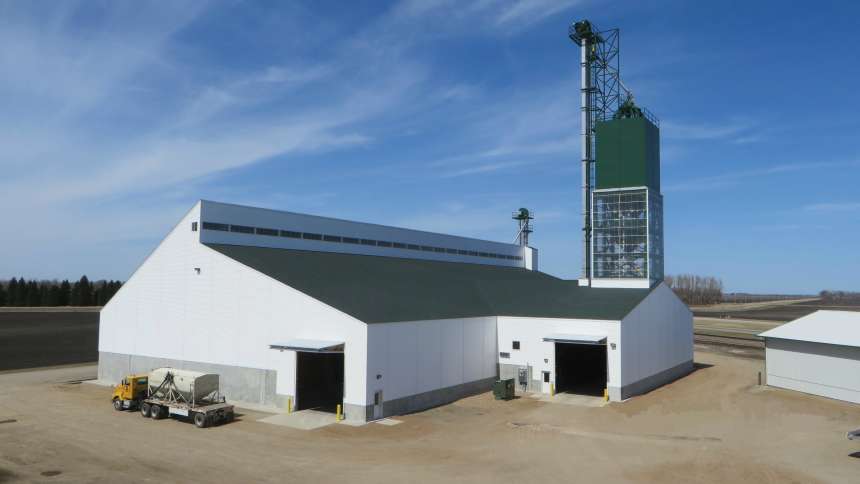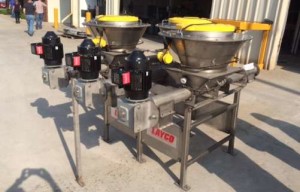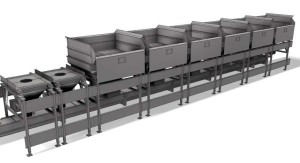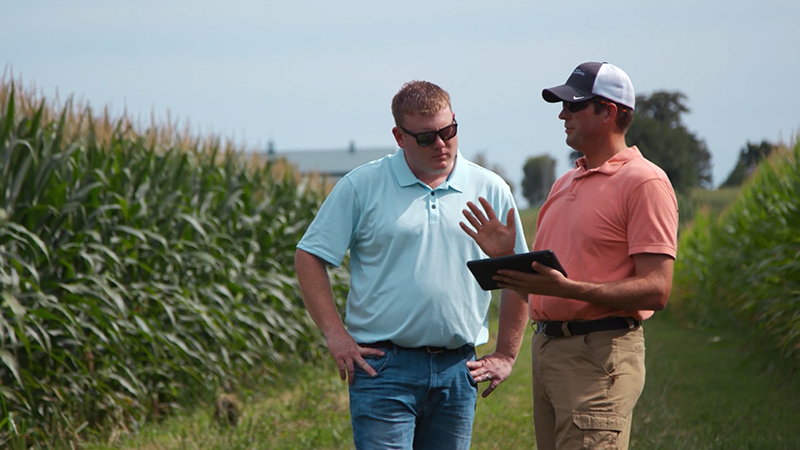Fertilizer Blenders Take On Latest Additives, Heavy Workloads

Waconia’s systems offer accurate and reliable receiving and loadout, easy-to-use controls, NTEP approved weigh hoppers and stainless steel product-contact areas.
As agronomy and precision ag sciences continue to advance, blender manufacturers have certainly had their part to play. “We are challenged with new products, more crop diversity and the like that require much more complex blending systems than have been needed before,” says Charles Formisani, Vice President, Sales at A.J. Sackett & Sons.
Then too, sheer volume demands in compressed application seasons have compelled manufacturers to offer ever larger and more efficient machines. They’re developing designs that can offer both “quality and quantity” in output.
Additives Expand
More fertilizer stabilizer and enhanced efficiency products are coming to market than ever before, notes Jeff Ivan, Vice President International Sales and Marketing with Yargus Manufacturing. “We feel this segment of the market will continue to grow and our fertilizer R&D group has focused on the application of these products as well as others,” he says.

The LAYCOTE Powder System from Yargus ensures powers are metered out accurately during the blending process.
Yargus has developed several application processes for both batch and automated systems. The company’s automated systems can handle both liquid and powder products. In fact, LAYCOTE Automated Coating Systems can coat fertilizers up to 400 US TPH quickly and accurately, says Ivan.
“The Layco DW Automated blending system can be designed to incorporate a phosphate inhibitor on one end of the process while a nitrogen inhibitor can be applied on the other end. The system would blend in the middle thus achieving the desired results for each product being applied.”
Bruce Hinkeldey with Ranco Fertiservice also continues to see a strong increase in the use of stabilizers/efficiency products, both liquid and dry. Most the company’s new blenders are being installed with declining weigh impregnation systems to handle liquid products.
“Our powder feeder accurately applies the dry stabilizers to the fertilizer. It uses an internal agitator that keeps the powdered product from settling and bridging,” he explains. “The meter screw accurately dispenses the desired amount of stabilizer onto the fertilizer and is regulated by our declining weigh system.”
Waconia Manufacturing’s Rob Henderson, Vice President, Sales and Marketing, foresees more stabilizers and enhancers being applied to nitrogen and phosphate products — as well as use of more micronutrient-enhanced products. But he’s found many facilities are running equipment that isn’t designed to handle these products and apply liquid enhancers. He believes that dealers with cutting-edge technology will be able to adapt to these changes, and “they will be able to apply the widest range of products, earning them business from those that can’t.”
To help ensure the best blends with advancing chemistries, A.J. Sackett operates a fertilizer research and development lab at its Baltimore location, offering testing to companies developing products such as polymers and the urease inhibitor NBPT.
“We see formulation changes ahead from these manufacturers — such as new products and more concentrated formulations being applied at lower quantities,” says Formisani. “These innovations can affect blend times needed so it’s important to build in the flexibility to be able to efficiently apply these products.”
Retailers’ Worries
Indeed, it can be difficult for retailers to try to predict the future blending needs of their facilities, Formisani says. “This kind of information is important as it plays a big part in selecting the best blending technology that will meet their future needs.” Retailers have to consider the types of value-added products to be used, new liquids (EEF’s, micros, biologicals, etc.) to be added, new chemicals and new application technologies.
“Misinformation is also a challenge,” Formisani says. “We spend a lot of time assessing customer needs and trying to help plan for the future to recommend the right system. We want our customers to build the system to fit today’s needs as well as years from now.”
Ranco’s Hinkeldey says his company’s systems are designed to be versatile and easily expandable in the future. Every blend system is specifically engineered to fit each location’s needs. “We avoid a ‘one size fits all’ approach,” he notes.
Another concern closer at hand? The spring season promises to be busier than normal, say most companies, because growers have waited to make fertilizer purchases and didn’t put down as much product this past fall. The increased work load “will put a strain on older equipment, making it more obvious to dealers that they must invest in faster, more reliable and more efficient equipment to compete,” says Henderson.
And if spring weather turns wet, the application window will be shorter — again, meaning more intense blender demands. “Dealers with the most up to date and efficient systems will win business from locations with older, slower systems,” he adds.
In fact, an equipment breakdown at one of its customer’s facilities is one of the biggest challenges Waconia faces every season, says Henderson. He emphasizes the company does its very best to minimize downtime for customers by designing systems for heavy seasonal demand, having the right parts on hand and providing timely delivery and support. Staff also stress diligent routine maintenance so dealers can optimize efficiency, prevent breakdowns, and ensure employee safety.
More Large Units Released
Manufacturers commented that they continue to see a trend towards larger blending systems for both batch and automated systems. For instance, in just the past few years, Doyle Manufacturing has released its 13-ton and 16-ton rotary blenders. The company built the first rotary drum blender in 1961.
“The Doyle Rotary Blend System combined with the Doyle Weigh Hopper Conditioner, gives retailers the capability to batch blend faster than ever,” says Monty Doyle, President.
This year Yargus added two larger rotary drum blenders to its Layco product line. The 13- and 16-ton drums allow for larger batch sizes to meet the growing demand for larger systems. Yargus has also developed a new six-legged Layco Tower system with a unique design that allows for a higher capacity and stair access, as well as a single tower for blending and wholesale fertilizer distribution.
“As customers look to higher blend volumes from their distribution centers, the Layco DW Automated blending systems are also continuing to grow in popularity,” says Ivan. Yargus has developed a unique LaycoTank DW System that utilizes large bulk storage tanks for the base fertilizers.
Sackett’s Formisani reflects that bigger does not necessarily mean better these days: Blend quality and speed are what’s important. He says Sackett’s precision fertilizer blending (PFB) technology is based on creating very fast, small batches so retailers get the best accuracy and blend quality. “This is a game changer in terms of being able to blend complex formulas with value added products, all with high quality and speed,” he explains.
“Also, with more multi-compartment tenders and VRT, we are seeing our small batch technology become even more important,” he says. “Many customers are putting six different blends in a single tender. This means multiple high quality, four-ton batches. PFB technology blends (weigh, blend and discharge) a four-ton batch in about a minute and with extremely high quality.”
Other New Offerings
It seems this year retailers are seeing more advancements than usual in blender lines.
Yargus has added the Layco Performance Mixer, horizontal paddle mixer that’s a new option for the Layco Blending Tower as well as for Layco Soluble Fertilizer Blending Systems. The Layco Performance Mixer is used extensively in the pharmaceutical and food industries due to its ability to blend products quickly and precisely, Ivan points out. The horizontal mixer is also able to coat fertilizers during the blending process.

Adams Fertilizer Equipment just expanded its blender choices to include a Declining Weigh Blender Line.
As Adams Fertilizer Equipment’s customers consolidate and advance to larger facilities, the company has just expanded its blender department to include a Declining Weight Blender Line. Shawn Hudspeth says the new decline-in-weight system was engineered to incorporate new technology with leaner and simpler ways to operate equipment “that surpass our customers’ expectations.”
Adams’ version of the DW blender — which Hudspeth says was also designed based on end user suggestions — consists of several hoppers inline that deliver a measured, weighted material to a large capacity conveyor underneath that thoroughly mixes the material blend as it transports the load to a tender truck. Hoppers (available in different capacities) are modular and are available with a metering auger screw or stainless steel mesh chain discharge. Operators can remove metering screws easily for maintenance with only four bolts.
“Interchangeable side guard mounts for both side loading and for greater capacity that converts from a 5- to a 10-ton capacity hopper,” adds Hudspeth.
Waconia, in conjunction with its business partner A.J. Sackett, is now offering a HIM (High-Intensity Mixer) Tower as well as its traditional TA vertical mixer tower. Henderson says the HIM Tower “provides unsurpassed quality blends, high-output rates and is extremely accurate.
“As more micronutrients and concentrated liquids are introduced into the market, dealers will need the ability to add these products without sacrificing speed, blend quality and accuracy,” he says. “The HIM mixer utilizes scale hoppers with as little as two-pound graduations, providing the highest accuracy. The HIM mixer has no dead zones, so every particle is blended continuously and completely. A typical batch only takes 30 seconds to blend, and chemicals can be added without increasing blend time.”
With its purchase of InterSystems, AGCO has entered the blending arena, and Nate Reznechek, Crop Nutrient Equipment Sales Manager, says the company “will have quite a few new systems that will be coming online this spring.” At presstime, AGCO wasn’t quite ready to tip its hat on designs, but information will soon follow.





